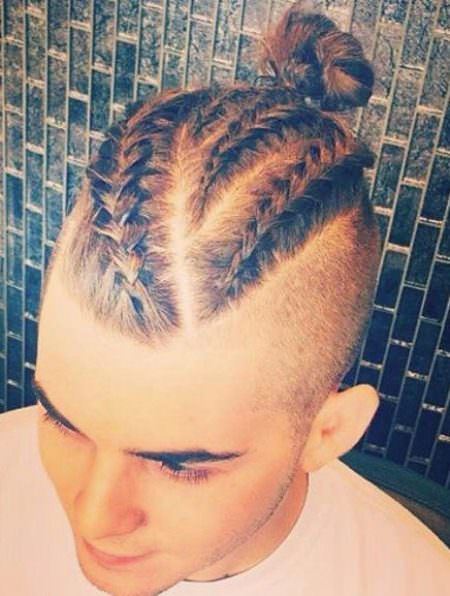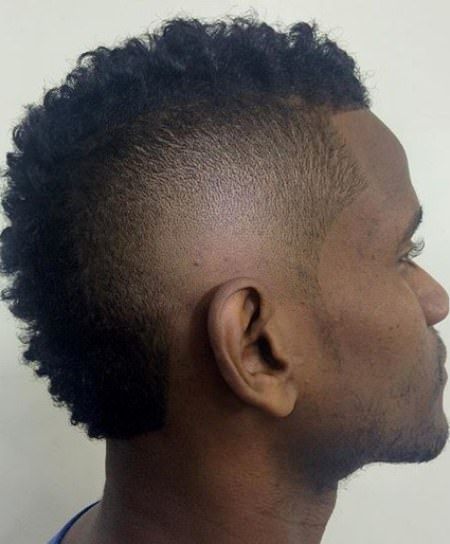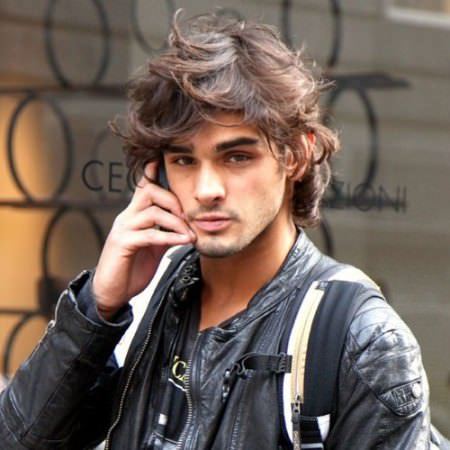#Modish braids for men
Explore tagged Tumblr posts
Photo

Best Braids for Men - #howrid
Published on http://lethow.com/hairstyles/best-braids-for-men/
Men are hairstyles are not always short or cropped. When you have long hair, you can add versatility to your look. It’s time to try something creative like braid hairstyles. You can opt for simple braid, fishtail or edgy cornrows that add texture in your tresses. In today’s trend, braid...
#15 stylish hairstyles for men#Best Braids for men#braids for men#Different Braids for men#Gorgeous braids for men#men hairstyles#mesmerizing braids for men#Modish braids for men#Ravishing braids for men#striking braids for men#stunning braids for men#top braids for men#trendy braids for men#Hairstyles
0 notes
Text
Black Beauty: Photography Between Art and Fashion
Antwaun Sargent adapted this essay from his new book, “The New Black Vanguard: Photography Between Art and Fashion,” to be published next month by Aperture.
In 2018, American Vogue published two covers featuring the global icon Beyoncé on its esteemed September issue. Though it was her fourth time fronting the venerable monthly, this was the shoot heard around the world: For the first time in the magazine’s century-long history a black photographer, Tyler Mitchell, had been commissioned to create its covers.
On one cover the musician is conveying a temporal softness and an air of modern domesticity in a white ruffled Gucci dress and Rebel Rebel floral headdress; on the other cover she is standing amid nature, wearing a tiered Alexander McQueen dress with Pan-African colors, her hair braided into cornrows. Her gaze is confident, a symbol of black motherhood, beauty and pride.
“To convey black beauty is an act of justice,” says Mr. Mitchell, who was just 23 years old when the photographs were published.
For Mr. Mitchell, the Beyoncé portraits, one of which was recently acquired by the Smithsonian’s National Portrait Gallery, are suggestive of his broader concern to create photography that contains “a certain autobiographical element.” Mr. Mitchell, now 25, grew up in Atlanta and was fascinated by art and fashion images he saw on Tumblr. “Fashion was always something distant for me,” he says.
His own images evoke what he calls a “black utopia” — a telegraphing of black humanity long unseen in the public imagination. In “Untitled (Twins II)” from 2017, he features the brothers (and fashion models) Torey and Khorey McDonald of Brooklyn, seen draped in pearls and resting against a pink and cream backdrop. The photographs document the style, identity and beauty of black youth — “what I see to be a full range of expression possible for a black man in the future,” he explains. His subjects are often at play in grass, smiling in repose and occasionally peer with an honest gaze at the camera.
Mr. Mitchell is a part of a burgeoning new vanguard of young black photographers, including Daniel Obasi, Adrienne Raquel, Micaiah Carter, Nadine Ijewere, Renell Medrano and Dana Scruggs, who are working to widen the representation of black lives around the world — indeed, to expand the view of blackness in all its diversity. In the process, they are challenging a contemporary culture that still relies on insidious stereotypes in its depictions of black life.
These artists’ vibrant portraits and conceptual images fuse the genres of art and fashion photography in ways that break down their long established boundaries. They are widely consumed in traditional lifestyle magazines, ad campaigns, museums. But because of the history of exclusion of black works from mainstream fashion pages and the walls of galleries, these artists are also curating their own exhibitions, conceptualizing their own zines and internet sites, and using their social media platforms to engage directly with their growing audiences, who often comment on how their photographs powerfully mirror their own lives.
In 2015, the South African photographer Jamal Nxedlana, 34, co-founded Bubblegum Club, a publishing platform with a mission to bring together marginalized and disparate voices in South Africa, and to “help build the self-belief of talented minds out there in music, art, and fashion.” Mr. Nxedlana’s Afrosurrealist images illustrate the stories of young artists from across the African diaspora. He sees his work as a form of visual activism seeking to challenge the “idea that blackness is homogeneous.”
It’s a perspective often seen in the work of this loose movement of emerging talents who are creating photography in vastly different contexts — New York and Johannesburg, Lagos and London. The results — often in collaboration with black stylists and fashion designers — present new perspectives on the medium of photography and notions of race and beauty, gender and power.
Their activity builds on the long history of black photographic portraiture that dates to the advent of the medium in the mid-1800s. More immediately, their images allude to the ideas of self-presentation captured by predecessors like Kwame Brathwaite, Carrie Mae Weems and Mickalene Thomas. What is unfolding is a contemporary rethinking of the possibilities of black representation by artists who illustrate their own desires and control their own images. In the space of both fashion and art, they are fighting photography with photography.
“The fashion image is vital in visualizing minorities in different scenarios than those seen before in history,” notes Campbell Addy, 26, a British-Ghanian photographer. Mr. Addy’s emerging archive gives pride of place to more fluid expressions of sexuality and masculinity in stylized images — like his untitled portrait of a shirtless black man whose face is covered in a makeshift red-and-white mask and his neck adorned with pearls and a rosary. “To play with fashion is to play with one’s representation in the world,” adds Mr. Addy, who also founded a modeling agency and the Niijournal, which documents religion, poetry, fashion and trends in photojournalism. “There’s a sense of educating the viewer,” he says.
Inspiration for Arielle Bobb-Willis’s pictures of black figures, whose faces are generally obscured from the camera’s gaze and whose bodies are captured in unnatural poses, can be found in the vivid canvases of modernist African-American painters such as Jacob Lawrence and Benny Andrews.
MS. Bobb-Willis is interested in how these artists applied a sly sense of abstraction in their portraiture, pushing representation beyond realism and stereotype. In her works, such as “New Orleans” (2018), a picture of a female figure wearing candy-colored garments as her body bends every which way before an abandoned storefront, Ms. Bobb-Willis, 24, showcases what she calls the personal “tension” of wanting to be visible in a culture that has long misrepresented the realities of black people.
For Quil Lemons, notions of family are a central concern. Mr. Lemons, 22, says his “Purple” (2018) series, striking portraits of his grandmother, mother, and sisters in his hometown Philadelphia, draw on a black-and-white photograph of his grandmother in a frontier-style dress. The four generations of women in his photos wear Batsheva floral print dresses that he selected to express a sense of home and intimacy. “The images are advocating, illuminating and cementing others’ existence,” says Mr. Lemons. “Overall, I’m offering insight or a glimpse into a world or life that could be overlooked.”
The British-Nigerian photographer Ruth Ossai, 28, also incorporates her own Ibo family in eastern Nigeria and relatives in Yorkshire, England. “I try to show texture, depth and love — the strength, tenacity and ingenuity of my subjects,” she explains. In Ms. Ossai’s elaborate, playful and fashionable portraits, they are dressed in a mix of traditional garments and western wear. She says of her photographs, “Young or old, my aunties and uncles flaunt our culture and sense of identity unapologetically, with a sense of pride and confidence.”
Her 2017 series, “fine boy no pimple” features her younger cousin, Kingsley Ossai, reclining in an oversized red suit and yellow durag while holding an umbrella, against a printed backdrop depicting a pastoral landscape. Much of her work, which sometimes incorporates collage and has been published in fashion campaigns for Nike and Kenzo, is inspired by contemporary West African pop music, Nollywood films and the pomp of Nigerian funerals. It is evocative of the African mise-en-scène studio portraiture of the 1960s, created by such artists as Sanlé Sory in Burkina Faso and Malick Sidibé in Mali.
The documentary nature of Stephen Tayo’s street snapshots of stylish shopkeepers, elders and youth in Lagos speak to this generation’s interest in recording contemporary black identity and its use of photographs as a space for fresh invention. His untitled 2019 group shot of modish young men huddled together on a street in colorful suiting showcases traditional Nigerian weaving techniques while alluding to the “youthquake” movement taking hold in his city. The image also conjures the post-independence street photography of the Ghanaian artist James Barnor.
“The current generation is keen on just believing in their crafts” says Mr. Tayo, 25, whose work is currently on view in “City Prince/sses” at Palais de Tokyo in Paris. “It’s also very to be part of a generation that is doing so much to regain what could be termed ‘freedom.’”
Images of the black body are not the only way these photographers consider notions of identity and heritage. The Swiss-Guinean photographer Namsa Leuba focuses on specific objects used in tribal rituals across the African diaspora to probe, conceptually, the way blackness has been defined in the western imagination. Ms. Leuba, 36, creates what she calls “documentary fictions” that possess an anthropological quality. In series like “The African Queens” (2012) and “Cocktail” (2011), her figures are draped in ceremonial costume and surrounded by statues imbued with nobility.
Awol Erizku, in addition to his celebrity portraits of black actors and musicians such as Michael B. Jordan and Viola Davis, creates powerful still life imagery filled with found objects set against monochromatic backdrops. They reference art history, black music, culture and nature. The works also highlight Mr. Erizku’s interest in interrogating the history of photography while disrupting existing hierarchies.
In “Asiatic Lilies” (2017), a black hand with a gold bangle holds a broken Kodak Shirley Card, named for the white model whose skin tone was used to calibrate the standard for color film. The hand is comparing the card to objects that have been whitewashed, including a bust of Nefertiti, painted black. Mr. Erizku, 31, also includes in his photograph a small gold sculpture of King Tut, and fresh lilies, the flower of good fortune.
The message for his generation of image makers is clear: “I am trying to create a new vernacular — black art as universal.”
Sahred From Source link Fashion and Style
from WordPress http://bit.ly/2PPb6ei via IFTTT
0 notes
Text
Nowadays men accessorize themselves wearing men’s leather bracelet
In actuality, bracelets tend to be famine and never considered to be strong. Nevertheless, you have read past record you will keep in mind that even nobleman and their players wore bracelets and armbands. Most civilizations followed this kind of trend. In order to ward off wicked even primitive men perform bracelets. This trend has seen plenty of evolvement over the period. In present times, men have taken up liking for this accessory so much so that, you get men’s bracelet in a number of designs. The actual designer men’s leather bracelet is apparently trending. And to match up with it men do not necessarily hesitate to decorate further along with statement rings. Women will find they are will no longer the only chosen ones to put on such decorative accessories but men also have found they can take pleasure in wearing them. However, mens fashion bracelets and women wear not similar type. These kinds of bracelets and statement rings in which men wear in present times are tough and also wild in appearance befitting to be worn simply by men just. Jewelry created for women are much delicate and not wild to look at. Just like ladies, men like to look stylish and they understand that accessories including mens fashion bracelets can give them a modish look. However, such tough seeking bracelets look good just on males having a of a man appearance. Bracelet is definately an accessory which goes well together with whatever you wear. No longer would be the jewelry sectors concentrating on offering newer designs for women but quite a number of designs for men are made nowadays. You get plain men’s leather bracelet and in addition others together with patterns and designs. Perhaps you have to visit the sites on men’s bracelet online you will be greeted with a huge option and find it hard to decide on. You get trendy, casual, braided, beaded, etc. In most parts of the world, the thought of men sporting such bracelets made from leather is considered to be typical and, is worn every day. Great liking for these stylish bracelets is shown nowadays by most men. Besides men’s leather bracelet another fashion, items several men embellish themselves are ear-rings, chains, men, pendants, and also necklaces. In addition to accentuating the particular wearer’s personality, you will find that bracelets also give added elegance to his / her personality. Men who love to use such add-ons do drop their veneer of inhibition. But alternatively, make sure that these kinds of accessories are very exposed for all to see hence, flaunting their particular fondness for such items that has mostly been reserved exclusively for women. Anyway, nowadays you will find a lot of the fashions are usually unisex. Take for example denims, shirts, coats, hair programs, etc. It is because women these days are trying their finest to be on elemen with guys and men trying to require famine styles. If you are considering wanting to know with the varied types of bracelets and where to procure all of them you should search on the internet. The selection available is so large you won’t understand which to choose. Besides accentuating the wearer’s personality, you will find that bracelets also impart added sophistication to his personality. For more infromation mens rope bracelets.
0 notes
Photo

20 Mohawk Hairstyles for Men - #howrid
Published on http://lethow.com/hairstyles/20-mohawk-hairstyles-for-men/
Mohawk hairstyles for men prove to be rebellious and outlandish hairstyle. There are plenty of ways are there to rock the Mohawk hairstyle. You can wear Mohawk casually and formally. Whether you are looking for the shaved sides of your head or a fauxhawk hairstyle, we have shared some amazing...
#20 mohawk hairstyles for men#20 stunning mohawk hairstyles#amazing mohawk hairstyles#best haircuts with mohawk hairstyles#best mohawk hairstyles for men#braided mohawks#different mohawk hairstyles for men#latest mohawk hairstyles for men#modish mohawk hairstyles for men#mohawk hairstyles for men#stylish mohawk haircuts#stylish mohawk hairstyles for men#top mohawk hairstyles for men#trendy mohawk hairstyles for men#Hairstyles
0 notes
Photo

20 Sporty Long Hairstyles for Men - #howrid
Published on http://lethow.com/hairstyles/long-hairstyles-for-men/
Many people in this world think that only women are concerned about their appearance and the latest trends. Nowadays men are equally concerned about their look and personality. When we talk about the overall personality, hair styling plays an important role. Another myth is that long hair is...
#20 classy A-line bob hairstyles#20 cool black braided hairstyles#20 gorgeous side hairstyles for prom night#20 modish layered hairstyles for long hair#20 splashy blonde hairstyles#20 sporty long hairstyles for men#20 stunning layered hairstyles for long hair#Best and trendy hairstyles for wedding seasons#Best and unique hairstyles for men to try this season#Different hairstyles for men with long hair#Hairstyles for men#hairstyles for men that are in trend#long hairstyles for boys#medium length hairstyles for men#professional hairstyles for men#Hairstyles
0 notes